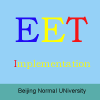-
Television in the classroom
普通类 -
- 支持
- 批判
- 提问
- 解释
- 补充
- 删除
-
-
Television in the classroom
SEEING IS BELIEVING. In many situations, seeing is remembering, too. Research suggests that a person remembers about twice as much when they see and hear something as when they only see or hear it. Thus, televisions' "multiple modes" or combination of images and sound have proven to be an influential aid in the learning process, resulting in more motivated students and improved learning outcomes.-
TV and Learning
TV's "Multiple Modes" can portray content through a variety of approaches.
Television can transform educational content into an engaging world of stories, pictures, ideas and sounds that students can actively explore. Kozma (1991) found that television's combination of multiple symbol systems—that is, its mix of spoken language, text, still images, and moving images —yields greater learning gains than media that rely primarily on one symbol system.
The learning benefits of television's "mixed message" can be found also in Howard Gardener's often cited learning theory of multiple intelligences. Television's multiple modes can portray content through a variety of approaches, such as linguistic, aesthetic, logical, and narrational, thus more effectively matching viewers' various intelligence "preferences" (Gardner, 1999). In a formal educational setting these "multiple entry points" into content are especially valuable as they offer greater access to the multiple intelligences of a diverse group of students.
Classroom activities frequently make use of more than one of the multiple intelligences. For example, making a video accesses the following "intelligences": Logical/Mathematical, Musical/Rhythmic, Verbal/Linguistic, Interpersonal, and Visual-Spatial.-
Choosing Appropriate Content
Teachers in many disciplines are finding creative ways to incorporate television and video into their classrooms. Repackaged broadcasts, program segments, and other content designed with educational intent, as well as in-class video production, have all been used to improve student outcomes. Content resides on multiple formats and a range of distribution modes, from video cassettes to CD-ROMs, DVDs, and the Internet.Not unexpectedly, research has shown that the value of video highly correlates to its integration with the curriculum. Wetzel (1994) cites the work of Chu and Schram (1975) who conclude that instructional uses of television were most effective when "interwoven into an integrated teaching/learning system in the context of other learning activities." Look for resources that help make your topics come alive. For example, find an interactive DVD-ROM that provides students with ways to experience a subject rather than reading about it. Use the content to stimulate class discussion and reinforce lectures and reading. Again, when selecting content for use in the classroom, make sure it fits into the overall instructional plan.
-
Teaching with Television
So, how do you start? First, plan ahead (Rogow,1997). Think about what you are trying to accomplish. Do you want to spark interest or inspire? Demonstrate something you can't do any other way? Enrich curricular content? Practice a skill? Reinforce or review a topic?
Next, Rogow (1997) suggests that teachers ask themselves the following: "Think of the TV as a teacher. Do you turn off the lights when you talk? Would you be satisfied with a class that sat and stared at you for 30 minutes without responding? Interactive viewing requires three simple steps."
Prepare: Set clear expectations and learning goals
Participate: Preface the viewing with a few key questions and/or learning objectives. Break students into small groups for discussion, and/or have them write down their thoughts, then share the results with the larger group.
Connect: Choose follow up activities that connect to hands-on or real-world experience.
Research consistently supports the value of teaching not just with television but about television. Promote media literacy by encouraging and developing critical viewing skills in your classroom.
Television is highly effective in conveying information, arousing emotions and promoting attitudes. However, student's expectations about television have been shaped by a lifetime of using television as entertainment. Consequently it's helpful for teachers to be aware of the students' attitudes about the medium.-
More Information
PBS Teacher Source
Teaching Heritage
On the Job in North Carolina
Relevant EET Articles
Howard Garder's Multiple Intelligences
Multimedia and Multiple Intelligences-
Author
Ric Shellhammer, Graduate Student
SDSU Educational Technology
Shellhammer, R. (2005). Television in the classroom. In B. Hoffman (Ed.), Encyclopedia of Educational Technology. Retrieved -
-
- 标签:
- educational
- modes
- television
- multiple
- students
- classroom
- learning
- teaching
- video
- intelligences
- content
-
加入的知识群:



学习元评论 (0条)
聪明如你,不妨在这 发表你的看法与心得 ~